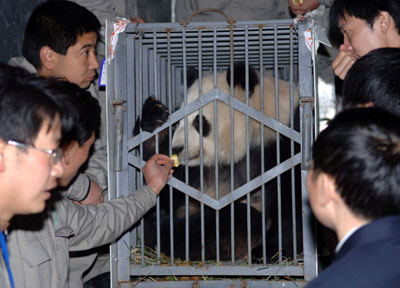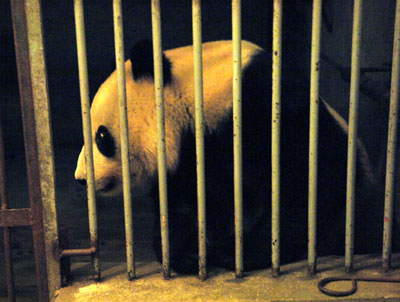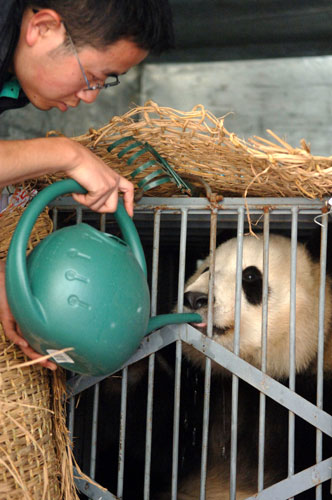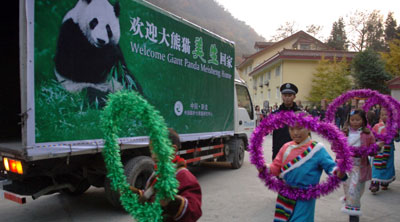A US-born panda has been greeted by crowds of well-wishers on its arrival in southwest China on Wednesday.
People carrying apples and fresh bamboo shoots turned out at the Wolong Giant Panda Nature Reserve in Sichuan Province to welcome Mei Sheng, who left San Diego Zoo on Monday, to his new home.
A keeper feeds US-born giant panda Mei Sheng while others look on at the Wolong Giant Panda Nature Reserve in Chengdu, Sichuan Province, on November 7.
A brief medical check for the four-year-old, weighing 85 kg, showed he was in good condition, said Li Desheng, deputy head of the China Giant Panda Protection and Research Center based in Wolong.
"But he still needs to be quarantined for one or two months, then he can officially enjoy life in his new home," he said.
The panda had been scheduled to leave the United States at the end of last month, but the departure was postponed due to a flight adjustment, said Li.
Experts from both the San Diego Zoo and the Chinese research center have escorted the panda on his journey.
Mei Sheng, which means "born in America" or "beautiful life" in Chinese, was born on August 19, 2003 at the San Diego Zoo in southern California. His parents were Bai Yun and Gao Gao, a couple lent to the zoo by China under a giant panda conservation and research program.
According to the cooperation agreement, cubs born overseas to pandas on loan belong to China and must be sent to China after they become sexually mature.
The first overseas-born panda, Hua Mei, Mei Sheng's sister, came back to China from the United States in 2004 when she was five years old. Hua Mei gave birth to a twins in autumn that year.
Hua Mei was artificially conceived while Mei Sheng was the first overseas-born panda conceived through natural mating.
"Mei Sheng is sexually mature, and his first job in China is to adapt to the environment here and look for a mate," said Zhang Hemin, head of the China Giant Panda Protection and Research Center.
"If he can come into heat smoothly in spring, he can join the reproduction program," he said.
China sent 24 giant pandas to nine countries as gifts from 1957 to 1982 and five of their offspring are still alive.
The government stopped the program in 1985 and launched long-term cooperation on giant panda breeding with Japan, the United States and Spain in 1994, since when, 25 pandas have been leased.
Giant pandas are one of the most endangered species in the world. Just1,590 giant pandas are estimated to live in the wild, most of them in southwest China's mountainous regions.
By the end of 2006, about 210 giant pandas lived in captivity in China.
(China Daily November 8, 2007)










